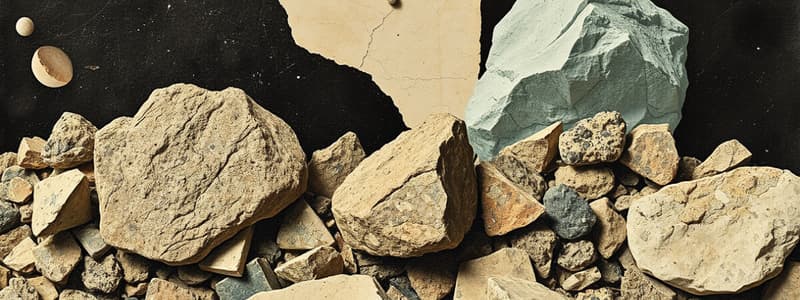Podcast
Questions and Answers
What percentage of the Earth's crust is composed of silicate minerals?
What percentage of the Earth's crust is composed of silicate minerals?
- Less than 10%
- About 50%
- Over 90% (correct)
- Exactly 75%
Rocks have a specific chemical formula.
Rocks have a specific chemical formula.
False (B)
What is the primary difference between rocks and minerals?
What is the primary difference between rocks and minerals?
Rocks can be organic or inorganic and do not have a specific chemical formula, whereas minerals are inorganic solids with a definite chemical composition and crystalline structure.
Silicate minerals make up over ____% by mass of the Earth's crust.
Silicate minerals make up over ____% by mass of the Earth's crust.
Match the following minerals with their classification:
Match the following minerals with their classification:
Which of the following characteristics is NOT used to classify rocks?
Which of the following characteristics is NOT used to classify rocks?
Igneous rocks can only form from volcanic activity on the Earth's surface.
Igneous rocks can only form from volcanic activity on the Earth's surface.
What term describes the transformation of pre-existing rocks due to heat and pressure?
What term describes the transformation of pre-existing rocks due to heat and pressure?
Sedimentary rocks can be classified as either __________ or __________.
Sedimentary rocks can be classified as either __________ or __________.
Match the following types of rocks with their descriptions:
Match the following types of rocks with their descriptions:
Flashcards are hidden until you start studying
Study Notes
Rocks and Minerals
- Rocks consist of two or more minerals or substances and must be solid and naturally occurring.
- Unlike minerals, rocks can be organic or inorganic, may have a crystalline structure, and lack a specific chemical formula.
- Minerals are naturally occurring, inorganic solids with a definite chemical composition and a crystalline structure.
- The Earth's crust is composed mainly of silicate minerals, which account for over 90% of its mass.
- Non-silicate minerals, making up less than 10% of the crust, include carbonates, oxides, sulfides, phosphates, and salts.
- Igneous rocks arise from the cooling of molten rock (magma/lava), classified as intrusive (plutonic) if formed underground, and extrusive (volcanic) if formed on the surface.
- Metamorphic rocks form from pre-existing rocks that undergo metamorphism due to heat, pressure, or chemically active fluids.
- Sedimentary rocks are categorized into detrital (formed from compacted particles) and chemical (formed from dissolved minerals precipitating out of water).
- "Mineraloids" include substances lacking crystal structure (e.g., mercury, opal) but may be classified as minerals in certain contexts.
- Organic minerals, despite being inorganic by definition, include exceptions like Whewellite, which have a definitive chemical formula.
Exogenic Processes
- Exogenic processes reduce Earth's relief and occur on its surface through weathering, erosion, mass wasting, and sedimentation.
- Weathering is the breakdown of rocks and minerals through physical or chemical means at the Earth’s surface.
- Erosion involves the removal of weathered materials by agents such as water, wind, glaciers, and gravity.
- Mechanical weathering (physical disintegration) includes abrasion, frost wedging, and salt crystal growth, often aided by water.
- Chemical weathering alters the molecular structure of rocks, with processes like dissolution, hydrolysis, oxidation, and carbonation affecting materials like limestone and chalk.
Endogenic Processes
- Endogenic processes generate relief by elevating and depressing land masses and are categorized into slow (diastrophism) and sudden movements.
- Diastrophism involves the deformation of the Earth's crust through folding and faulting, classified into epeirogenic (continent-forming) and orogenic (mountain-forming) movements.
- Volcanism refers to the eruption of magma from the Earth, while magmatism concerns the movement and solidification of magma, leading to new igneous rocks.
- Earthquakes are vibrations of the Earth's crust due to tectonic plate movements and are characterized by intensity (effects) and magnitude (measured using seismographs).
Activities
- Identify key geological features of rocks, minerals, and processes such as solidification of molten rock, composition of rocks, and characteristics that differentiate minerals and rocks.
Studying That Suits You
Use AI to generate personalized quizzes and flashcards to suit your learning preferences.



